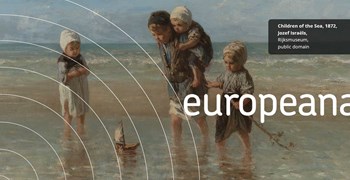Advertising and Art Nouveau in the machine age
In today’s #ArtNouveauSeason guest post, Francesc Quílez, Curator of Prints and Drawings at the Museu Nacional d’Art de Catalunya, describes how commercial artists at the turn of the 20th century adopted Art Nouveau style to create vibrant advertising images.
At the turn of the 20th century, a public fascination with machines and modern transport, linked to concepts of technological progress, was vividly reflected in advertising of the era. Many of the posters held in the Museu Nacional d’Art de Catalunya’s collection take travel and motion as their subject, depicting bicycles, cars, ships and aeroplanes.
Artists like Georges Gaudy (1872-1940) and William Henry Bradley (1801-1857) subtly incorporated stylistic elements of Art Nouveau (known as modernisme in Catalonia) into their commercial work, using floral motifs, bold outlines and areas of pure colour. Sporting themes were common on posters of the era, which depicted sports clubs and public events such as motor races and sailing regattas. The poster images are often highly aspirational, reflecting the fashion, wealth and social status of the growing bourgeoisie.

Georges Gaudy, Automobile Club Belgique. Course Bruxelles – Spa, 1898. Museu Nacional d’Art de Catalunya, CC BY-NC-ND
The arrival of the automobile generated a range of reactions. Poster artists sometimes viewed the car with an ironic and suspicious gaze, depicting contemporary automobiles as if they were infernal machines. To convey the sensation of speed, artists used a visual language that their audience would have been familiar with from illustrated newspapers, magazines and cartoons of the period.

Georges Gaudy, Automobile Club Belgique. Course Bruxelles – Spa, 1898. Museu Nacional d’Art de Catalunya, CC BY-NC-ND
Advertising posters, with their striking typography and bold colours, were received with great enthusiasm as a popular new art form. Catalan graphic art, exemplified by the works of Alexandre de Riquer and Ramon Casas, embraced the new visual opportunities of the modern age and contributed to its popular iconography. In particular, Casas is renowned for creating two of the era’s most emblematic posters, which became popular icons of modern Barcelona.

Ramon Casas. Ramon Casas and Pere Romeu on a tandem, 1897. Museu Nacional d’Art de Catalunya, CC BY-NC-ND

Ramon Casas. Ramon Casas and Pere Romeu in an Automobile, 1901. Museu Nacional d’Art de Catalunya, CC BY-NC-ND
Conceived as mere amusements and associated with the decoration of the bar Els Quatre Gats, Ramon Casas and Pere Romeu on a tandem and its four-wheeled counterpart Ramon Casas and Pere Romeu in an automobile are elegant subversions of the hierarchy between fine art painting and the poster. Few works better sum up the fertile opportunities that the arrival of modern advertising presented to contemporary Catalan artists.














